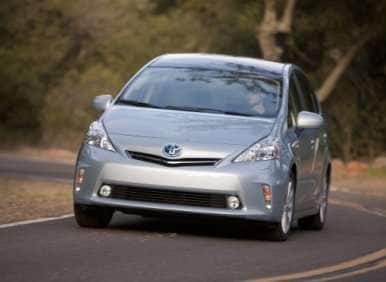Recent Articles
Popular Makes
Body Types
2012 Toyota Prius V Road Test and Review
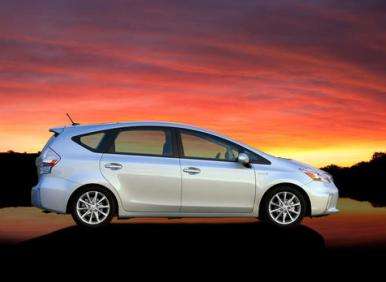
"Toyota Prius wagon" - if that particular phrase has never entered your mind, then you probably won't understand why the Japanese brand went ahead and expanded the already successful Prius lineup to include a larger, more passenger-and-cargo friendly edition of the hybrid hatchback dubbed the Toyota Prius V. If, however, you have been longing for a battery-powered family vehicle that offers excellent fuel economy and doesn't come in crossover-sized proportions, then a Prius wagon would seem to be exactly what the doctor ordered.
The 2012 Toyota Prius V is the initial foray into making the Prius it's own unique sub-brand. This beefier, yet still efficient new member of the hybrid family doesn't disappoint when it comes to serving its mission of providing ample space without sacrificing much of the unique charm that has made the standard Prius far and away the most popular battery-assisted car on the market.
2012 Toyota Prius V: Competition
The 2012 Toyota Prius V doesn't exactly have any direct hybrid rivals, as similarly-sized battery-powered models like the Ford Escape Hybrid have their feet planted firmly in the SUV camp. Broadening the search to include wagons that boast excellent fuel mileage reveals the Volkswagen Jetta Sportwagen TDI, whose diesel mill offers the closest competition to the Prius V. The Mazda MAZDA5 is roughly the same size as the Prius V, and offers a more engaging driving experience, but it doesn't even come close in terms of overall efficiency. The same goes for the Subaru Impreza hatchback, which leaves the Toyota Prius V essentially alone in its class.
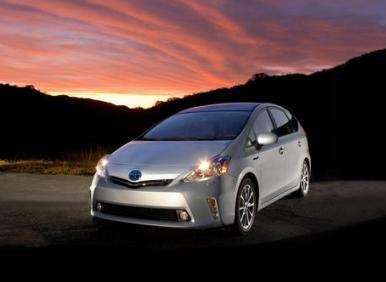
2012 Toyota Prius V: Pricing and Trim Levels
The 2012 Toyota Prius V, like the hatchback Prius, is offered in several different trim levels designated by a number. The Prius V Two represents the entry-level model, and it can be had for an MSRP of $26,550. Stepping up to the Prius V Three increases that figure to $27,315, while the top of the line Prius V Five checks in with an MSRP of $30,140.
Toyota makes available a number of different options packages that can push the final price of the Prius V even higher. The vehicle we drove was a Canadian-spec Prius V Three that offered a significant number of luxury features, bringing the total MSRP to $31,550 CAD. A roughly-equivalent US edition of the vehicle would cost $36,480, due to differences in how features are grouped together in each trim level and package.
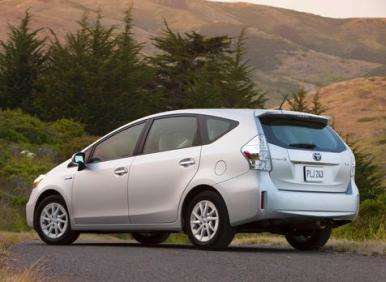
2012 Toyota Prius V: Exterior
The 2012 Toyota Prius V doesn't offer any surprises in terms of its exterior styling. Essentially, the Prius V expands the original Prius hybrid's footprint in every possible direction, a fact that becomes most apparent when considering the taller roof and longer wheelbase (roughly three-inches more of each when compared to the compact Prius). The Prius V isn't a large vehicle by any means, but just how much bigger it is when compared to its progenitor is something that has to be seen to be believed by longtime fans of Toyota's premier hybrid.
From a details perspective, the Prius V wears simple styling that some might consider anonymous. Flat from the front, undistinguished along the sides, and with nicely-jeweled tail lights framing the rear hatch, the Prius V wagon wears its modest looks well and makes no attempt to be something it's not. This is a purpose-built vehicle that isn't meant to appeal to the passionate side of a potential buyer's brain, but rather the logical one.
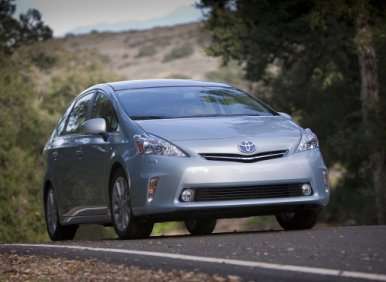
2012 Toyota Prius V: Interior
The 2012 Toyota Prius V boasts a truly enormous passenger compartment that features more than enough room at all five seating positions. In fact, it’s impossible not to be impressed by just how open and spacious the Prius V's interior has been designed to be. As expected, those riding up front are afforded with ample accommodations for legs, hips and shoulders, but the second row - which can slide backwards and forwards - is actually a comfortable enough place to spend more than a few hours out on the road, even for those who typically rue being relegated to the back seat in anything other than a full-size sedan. Toss in the fact that our test vehicle came with a dual-panel sunroof (made of a special, lightweight resin), and the light streaming into the Prius V's cabin helps to add even more to the wagon's plus-size passenger compartment feel.
Cargo space in the Toyota Prius V is also exceptional in comparison to the standard Prius, boasting over 70 percent more room and topping out at 67.3 cubic feet with the rear row folded down. Half of that room is actually usable with the seats up, too, which makes the Prius V a more-than-decent option for family trips that require overnight bags to be toted along.
Interior materials are generally nice to look at and equally pleasant to touch, particularly the soft covering afforded the dashboard, center console, and door panels. The seats themselves were upholstered in what Toyota calls 'simulated leather,' and offered comfortable support at all times.
The Prius V features a center-mounted gauge cluster that rises up out of the expansive dash panel like Ayer's Rock and which contains an array of completely digital readouts that reflect the automobile's speed, which power mode it is currently in, fuel mileage, odometer readings, and battery charge. One quickly becomes used to its central position, although it never stops feeling quirky.
"Quirky" is also the perfect word to use when describing the Prius V's gear selector. Featuring an electronic continuously-variable automatic transmission that works to manage power from both the electric and gasoline-powered motors, the Prius V offers an unusual method for actually getting the car in and out of gear. A blue knob that juts out from the left side of the center dash panel provides the ability to shift the wagon into Drive, "B" (more on "B" later), and Reverse. Want to put it in Park? You have to push the rectangular "Park" button sandwiched between the knob and the round "Power" button that starts and stops the automobile. Why can't I simply shift the car into Park, you might be asking yourself? This is an excellent question, as the setup feels unnecessarily overwrought.
As far as the rest of the Prius V's dash controls go, everything is relatively straight forward. A large climate control knob sits at the bottom of the center stack alongside a few complementary buttons, while the vehicle's LCD navigation screen also pulls duty as the radio tuner, phone interface, and media source selector. Hitching up a mobile phone to the Prius V via Bluetooth was an easy task, and the voice command system for making calls or entering destination information performed flawlessly. Our only issue had to do with some of the sound system's nested menus, which occasionally frustrated our efforts to drop the mids and pump up the bass.
One small ergonomic mishap struck us an unusual oversight from Toyota. Ahead of the center console and nestled underneath the dash are a 12-volt power outlet, a USB/AUX input, and strangely, the heated seat controls for both driver and passenger. There's really no reason for these buttons to be so inaccessible - especially for the person seated in the right-side seat.
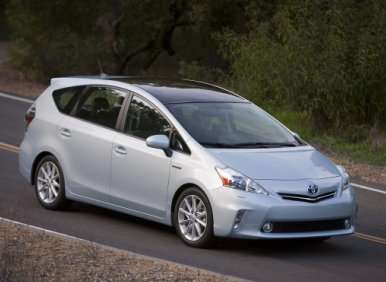
2012 Toyota Prius V: Powertrain and Fuel Economy
The 2012 Toyota Prius V makes use of the same Hybrid Synergy Drive system found in the more compact Prius. A 1.8-liter, four-cylinder engine works together with a team of two electric motors to produce 134 horsepower and 153 lb-ft of torque, sent to the front wheels via the previously-mentioned continuously-variable automatic transmission. Fuel mileage for the Prius V checks in at 44-mpg in city driving and 40-mpg on the highway, numbers that fall short of the original Prius due to its larger size, reduced aerodynamic efficiency, and 200 lb weight gain.
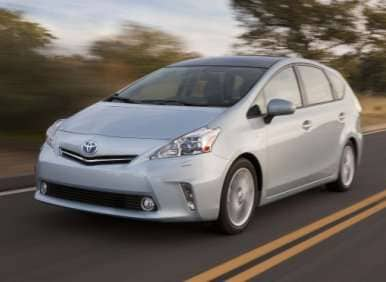
2012 Toyota Prius V: Driving Impressions
The 2012 Toyota Prius V should be approached with a very specific attitude that tempers expectations regarding the driving experience that it has to offer. Make no mistake: the Prius V is a well-designed appliance that will transport passengers and a significant amount of gear from one place to another while turning in excellent fuel economy figures in the process. This means that the Toyota Prius V isn't meant to be judged by the same yardstick as several of its competitors. The wagon offers a respectable turn radius and well-weighted steering, but its handling doesn't thrill drivers, nor does it invite an exploration of its limits. The vehicle's suspension system does a good job of absorbing bumps in the road, and it is actually quite difficult to shake the rear end free when traveling over rough pavement, but road noise is a constant companion whether traveling in an urban environment or when hearing the wind whistle out on the highway. Speaking of the wind, the bigger surface area of the Prius V means that larger gusts can push the car across its lane when traveling at higher speeds, which translates into greater need for steering corrections while underway.
Power delivery is the main area where the extra weight of the Prius V comes into play. Although it features a more aggressive rear end gear ratio than the compact Prius, and also offers a larger battery cell, the hybrid doesn't leap off of the line, nor does it provide a reassuring surge of power when you pull out to pass a slower vehicle. In addition to Drive, the Prius V features three drive modes: EV, ECO, and Power (you can also shift the car in to "B" to add engine braking to the equation when out on the highway). EV allows the vehicle to operate on battery alone slightly longer than normal, while Eco dials back the juice in order to conserve as much fuel as possible. Power is intended to offer extra grunt and erase much of the hesitation that can occur when stepping on the accelerator in Drive or ECO.
Most drivers will want to avoid ECO - especially when the vehicle is loaded up - unless they are dedicated hyper-milers, as the sluggish performance of the Prius V while set to this mode gets old, fast. Most of the time, we left the vehicle in Drive and let the hybrid system figure out whether we could cruise along in EV mode or whether we needed the additional guts provided by Power. In any case, expect a raspy delivery if you need to get somewhere in a hurry, as the small four-cylinder engine has to work fairly hard to hustle the Prius V down the road.
There was one issue that we found irritating about driving the Toyota Prius V. When the vehicle is shifted into reverse, it beeps at the driver. Constantly. Almost as though you are piloting a semi-truck. Perhaps this feature can be turned off, but if so, we couldn't figure how. So far, no other vehicle we have driven has felt the need to use an audible reminder to let us know we had shifted into reverse.
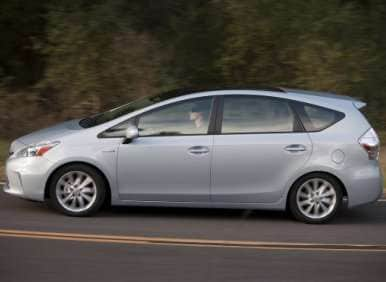
2012 Toyota Prius V: Safety
The 2012 Toyota Prius V features Toyota's Star Safety System, which includes electronic stability control, traction control, brake assist, and electronic brake-force distribution. Forward airbags, seat-mounted side airbags, side curtain airbags, and a knee airbag for the driver are also provided free of charge. Optional on the top-end Prius V is a pre-collision system that works in conjunction with adaptive cruise control to slow the vehicle down if an imminent impact is detected, as well as the Safety Connect telematics system that offers stolen vehicle tracking and the ability to automatically notify first responders in the event of an accident.
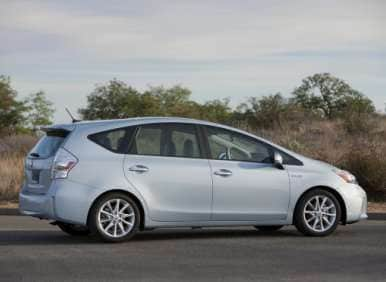
2012 Toyota Prius V: Final Thoughts
With the right mindset, the 2012 Toyota Prius V doesn't disappoint in terms of its performance. Modest driving dynamics are par for the course in the world of affordable dedicated hybrids, and our only real complaint was a lack of refinement when it came to details like road noise. This cheapened the experience somewhat for us when driving the wagon.
Fuel mileage, for a vehicle of its practicality, is obviously the main selling point when discussing the Prius V, and it also doesn't hurt that the vehicle is extremely roomy and comfortable front and rear. If Toyota could give the wagon a little more power - without sacrificing miles per gallon - then they would have an even more potent package to sell to family shoppers.
What We Like About The 2012 Toyota Prius V
- Fuel mileage is as-advertised (read: great).
- Exceptional interior room for people and cargo
- Comfortable seats, well-trimmed interior
We Aren't So Hot On:
- Shifter / Park button setup
- Unimpressive, and occasionally laggy acceleration
- Intrusive road noise
